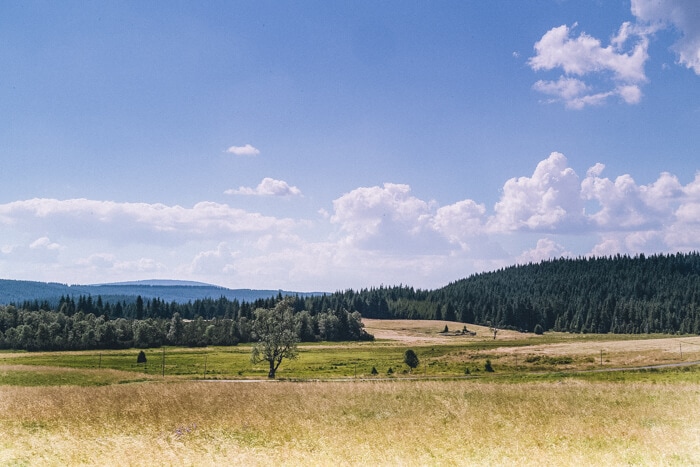Planning a trip to Czech Republic? This Czech Republic Holidays Guide will help you with information on what to do in Czech Republic, how to get there, what practical things to take into account, what to eat while you’re there, what to pack and much much more.
The Czech Republic is the 21st largest country in Europe, and it shares its borders with Poland, Germany, Austria, and Slovakia. The Czech Republic used to be known as Czechoslovakia, but it split with neighboring Slovakia in 1991. Now, it is a member of both NATO and the EU. It joined NATO in 1999, and the EU in 2004.
In 2015, the Czech Republic welcomed a record 27.8 million tourists, and the numbers have been steadily increasing every year. The most popular destination is the capital city, Prague, which welcomes a diverse range of tourists thanks to its history and culture, beautiful architecture, and a wide range of beers. Other popular tourist destinations in the Czech Republic include Karlovy Vary, Cesky Krumlov, and Plzen (where pilsner beer was invented).
The Czech Republic is also the castle capital of the world, with more than 2,000 castles and ruins.
Contents
- Czech Republic holidays: quick facts
- Czech Republic regions
- How to travel to Czech Republic
- How to travel around Czech Republic
- What to pack for Czech Republic
- The best time to travel to Czech Republic
- What to eat in Czech Republic
- Famous events in Czech Republic
- Public holidays in Czech Republic
- Cultural customs to be aware of in Czech Republic
- Where to stay in Czech Republic
- Basic phrases and their pronunciation
- Safety in Czech Republic
- The use of cash and cards in Czech Republic
- Calling abroad, WiFi and data use in Czech Republic
- Tipping in Czech Republic
- A brief history of Czech Republic
- Posts about Czech Republic
- Pin for later
Czech Republic holidays: quick facts
Size: 78,866 km² or 30,450 sq mi
People living there: more than 10,550,000
Capital: Prague
Governmental structure: Unitary parliamentary constitutional republic. The President is the head of state and the Prime Minister is the head of the Czech government.
National day: October 28
Time zone: Central European Time (CET) / UTC+1 / GMT+1
Currency: Czech Koruna (CZK). At the time of writing, roughly 25CZK = €1.
Power voltage and socket type(s): 230V, plug types C and E. If these don’t match with your devices, make sure to bring a universal adapter.
Official religion(s)/Freedom of religion: Freedom of religion. 80% of the population is not religious followed by Roman Catholic and believers not identified with a specific religion.
Official language(s) and general knowledge of English: Czech is spoken by nearly all of the population. English is widely spoken.
Drives on this side: Right
International driver’s license accepted? If you don’t have an EU driving license, you must get an international license before driving in the Czech Republic.
Phone code: +420
Vaccinations needed? No
Is the tap water safe to drink? It’s safe to drink in Prague and other large cities but you might want to use bottled water in rural areas just to be safe. Consider getting a Steripen that you put into your reusable water bottle so you can drink tap water anywhere.
Want more diverse quick facts about the Czech Republic? Check this list.
Czech Republic regions
There are 14 regions in the Czech Republic:
Prague
The biggest city in the country and the capital of Czech Republic Prague is the most popular tourist destination in the country. Situated on the Vltava River, it is overlooked by Europe’s largest castle and is famous for its Romanesque, Baroque, Renaissance, and Gothic architecture as well as its Old Jewish Quarter. It’s hugely popular with tourists, and the 1.3 million population is swollen year-round by those who want to get to know this stunning city.
Going to the Czech capital for the first time? Read my recommendations for things to do in Prague as well as where to eat in Prague.
Central Bohemia
One of the most beautiful regions in the country, Central Bohemia is dotted with castles, silver museums, mines, and great hospitality. Visit the town of Kutná Hora, where the historical center is listed as a UNESCO World Heritage site. The majority of Central Bohemia is easily accessible from Prague.
South Bohemia
Another easily accessible region from Prague, South Bohemia has a great mixture of culture and history, but a fair bit of adventure sports thrown in too. Here, you can hike and cycle, and even do water sports like rafting. The top site here is the village of Cesky Krumlov, another UNESCO World Heritage site.
Vysočina
“Here ends bread and begins stone” is the most commonly said sentence about Vysočina. This region, located between Bohemia and Moravia is a great place to get out and about and try some adventure sports, as well as visiting the towns of Telč and the capital Jihlava.
Plzen
A must visit region for beer lovers, Plzen or Pilsen is where “liquid bread” was invented in 1842 and has since become the beer against which all others are measured. There’s more than just beer, though. The city’s beautiful historical center is especially worth a visit in November and December when there’s a great Christmas market.
Karlovy Vary
Karlovy Vary is the best-known town in the world-famous West Bohemian spa triangle and has long been a haunt for the rich and famous. After Prague, the spa town is the most visited location in the Czech Republic. As well as unbeatable spa treatment centers, Karlovy Vary hosts a huge film festival every summer.
Ústí nad Labem
A city on the banks of the Elbe river, Ústí nad Labem is almost unheard of outside of the Czech Republic, but it’s certainly worth a visit. Delight in the wonderful architecture of Strekov Castle or the Church of the Assumption of the Virgin Mary, built in Gothic style.
Liberec
Set in a beautiful location, Liberec is a year-round destination where you can spend time strolling around the cobbled streets of the historical city. If you’re more of an adventurous soul, there’s plenty to do in the surrounding Jizera mountains. Liberec offers the perfect harmony of architecture and nature.
Hradec Králové
Hradec Králové is one of oldest cities in Czech Republic and a must visit for any with an interest in history and architecture. You’ll be able to take in Baroque, Renaissance, Romanesque, and gothic architecture like in Prague, but without the crowds. It’s also a great place to get out into nature, as two rivers meet here.
Pardubice
Pardubice is found in the Labe lowlands and is a great place to visit on a holiday to the Czech Republic. The region is famous for its meadows, forests, and canals, while the city of Pardubice is a horse racing center, where the famous Velka Pardubice (Pardubice steeplechase) takes place every year.
Olomouc
Ranked by Lonely Planet as one of Europe’s 10 hottest destinations as recently as 2013, this hidden treasure is a great alternative to Prague, thanks to its interesting architecture, fantastic nightlife, and authentic atmosphere. It’s a great destination to try Czech cuisine too, with a number of excellent restaurants in the old city.
Moravia-Silesia
Famous for its unusual folkloric traditions, this area of the Czech Republic is mysterious and exciting. It’s home to the most extensive landscaped countryside in the world with several historical towns, thousands of caves, and four UNESCO World Heritage sites. It’s one of the best places to visit in Czech Republic to try wine too, with a number of vineyards in the region. Lastly, the capital of Ostrava makes for an interesting city trip destination.
South Moravia
The first known settlements of the Czech Republic are found in South Moravia, and it’s a great place to visit for nature and history lovers alike. The warmest climate and most fertile lands are found here, and it’s a great place to try traditional Czech food, and of course, wine! The capital of South Moravia is Brno.
Zlín
Zlín is a city that loves its motorsport – including rallying, classic racing, and motorbike racing. A modern city, it’s a great example of a functionalistic city, with interwar modern urbanism and minimalist architecture. The wider region is home to highlands, castles, gardens and quite a few smaller museums.
How to travel to Czech Republic
Entry requirements
EU countries, countries within the Schengen zone, and US and Canadian citizens do not need a visa to visit the Czech Republic. However, you must have a passport that is valid for another 90 days after leaving the country.
Transportation
By bus
For those traveling overland, you don’t need to worry about border crossings as the Czech Republic is in the Schengen zone, although there may be police spot checks, so you should always keep your passport on you. There are a number of agencies from all surrounding countries that offer international bus travel into the Czech Republic, with many services terminating and leaving from Prague’s Florenc bus station. Find out about departures and arrivals at www.florenc.cz
A big bus company offering budget bus trips to Czech Republic is Flixbus. Check their site for routes and prices.
By train
The Czech National Railway has good connections to surrounding countries, and Prague is an extremely popular stop for travelers who are interrailing. The main international train station is Praha hlavní nádraží. From there, you can travel onward by train, or into the city on Prague’s tram system. There are also international train stations in Brno and Olomouc.
Check here for train routes and prices within Europe.
Flights to Czech Republic
When you fly to Czech Republic, it’s most likely that you’ll fly to Prague’s Vaclav Havel Airport. It’s the main point of entry for international travelers by air. There are also international airports in Brno, Ostrava, Karlovy Vary, and Parudbice.
Check Skyscanner for a good overview of flight options and prices.
How to travel around Czech Republic
Independent travel around Czech Republic
The Czech Republic is quite a small country, and it’s not difficult to travel around solo. It’s a very popular country with interrailers, and travel between the biggest cities is easy to do by train. However, if you don’t have an interrail pass it’s a good idea to consider using the buses. They are often cheaper than standalone train tickets and can easily reach out of the way towns.
Traveling by bus is also an easy way to get between cities. It’s often quicker and more convenient than the train, especially when traveling to hard to reach towns like Karlovy Vary.
Of course, you can also always rent a car for full flexibility and to reach even the tiniest towns and remote nature areas. Driving in Czech Republic isn’t harder than anywhere else in Europe. Just make sure to stick to the speed limits and not drink any alcohol as there’s a zero tolerance for drinking when driving.
Looking for a rental car? Check out Rentalcars.com. This site compares hundreds of rental car companies to make sure you get the best deal.
What to pack for Czech Republic
The Czech Republic is located in a temperate climate zone and therefore has four distinct seasons as most of Europe does. If you’re coming from outside Europe, don’t forget to bring a universal adapter.
What to pack for Czech Republic in summer
Mild and humid, with intermittent hot spells, the temperature usually reaches 20 – 25 Celsius, but it can get as high as 30 occasionally between June and September. Bring an umbrella and a raincoat, as sometimes sudden heavy rain and thunderstorms can catch you out.
If you’re heading into the great outdoors, use a sturdy pair of hiking boots or shoes, and plenty of gear to keep you warm, whichever time of year you’re visiting.
If you’re planning a boat cruise, it can be chilly at any time of the year, so bring something warm. The sun can also reflect on the water, so it’s a good idea to have suncream too.
Essentials:
- a raincoat
- suncream
- comfortable shoes
- good walking sandals
- light, cotton clothing
- sunglasses
- a reusable water bottle
What to pack for Czech Republic in winter
Winters are humid too but can get very cold, with the temperature ranging from -5 – 10 celsius between Mid-November, when the first snow starts to fall, and Mid March. Days are short, and winters are often cold, icy, and cloudy.
Essentials:
- a warm, waterproof coat
- a merino woolen baselayer
- a fleece or woolen jumper or cardigan
- merino woolen socks
- merino woolen leggings to wear underneath your trousers
- waterproof, warm and comfortable shoes
- snow boots
- a hat
- a fleece buff
- warm gloves
- a reusable water bottle
What to pack for Czech Republic in fall
If you’re lucky enough, you’ll experience the babí leto (Indian Summer) in September and October. After that, the temperatures start to drop and the days get shorter, sometimes dropping below 0 as fall turns becomes winter.
Essentials:
- a lightweight rain jacket
- a jumper or sweatshirt
- comfortable shoes
- a hat and scarf (just in case)
- a reusable water bottle
What to pack for Czech Republic in spring
Spring is a beautiful time to visit the Czech Republic, but it can still get pretty cold. In March, temperatures can still drop below 0°C so make sure to have some winter gear like merino woolen socks and a merino woolen baselayer with you. Other than that, it’s good to bring layers so you can adjust to the weather. A waterproof jacket and comfortable shoes are a must as well.
The best time to travel to Czech Republic
The best time to visit when you like traveling in warm weather is between May and September. Daylight hours are much longer during this time of year too but be aware that it can get really hot during the summer and accommodation in rural areas might not have air conditioning.
If you don’t mind the cold, come in November or December, when many cities have charming Christmas markets on. It’s a great chance to get some unique gifts, and it’s cheaper than neighboring Germany.
What to eat in Czech Republic
Czech cuisine is hearty, and perfect for warming up on a Winter day. Don’t worry it still tastes good in summer too. As well as many soups, it’s pretty heavy on carbs – think lots of meat and potatoes! Here are the 10 you should try on your trip.
Kujada
A great winter warmer, Kujada is a hearty soup in which you’ll find sour cream, potatoes, mushroom, all seasoned with dill. Sometimes you’ll have a quail’s egg dropped into the top too.
Goulash
There are many variations of goulash in Eastern Europe, and the Czech version of this soup is made with beef and is accompanied by either bread of a potato dumpling.
Chlebičky
The Czech Republic’s answer to the Scandinavian smorgasbord. This open sandwich is a delicious snack which often features egg, potato salad, cured meat, or pickled herring.
Svíčková
A hearty dish consisting of beef, whipped cream, and cranberry sauce. Sounds like an odd mix, but definitely worth trying!
Vepro Knedlo Zelo
A staple of Czech menus, this dish of roast pork, dumplings, and pickled cabbage is a nationwide favorite.
Roast Goose
Enjoy this on St Martin’s day in November. Roast goose comes with knedlíky (traditional dumplings) and stewed red cabbage.
Moravsky Vrabec
Although it translates into English as Moravian sparrow, this is actually a pork dish served with dumplings and cabbage, often accompanied with a cold beer.
Perníky
One for those with a sweet tooth, beautifully decorated gingerbread can be found all over the country. A great time to try it is during the Christmas markets.
Trdelníky
Shush, it’s actually from Transylvania! However, the column-shaped cake is synonymous with Prague, the capital city of Czech Republic, and you can try it with chocolate, ice cream, or Nutella.
Find out which ones of these I’ve tried on a Prague food tour;
Beer
Okay, it’s not a food but you can’t come to the Czech Republic without trying one of the country’s most famous exports. Pilsner Urquell and Staropramen are the most popular, and they’re super cheap.
Famous events in Czech Republic
1.Masopust
The Czech Republic’s answer to Mardi Gras, the name of this festival translates into English as “Goodbye to meat”. In recent years, it has grown to celebrate both Czech and international cultures and it’s characterized by music and parades. Masopust is celebrated in February.
2. Witches’ Night
Pálení čarodejnic, also known as Witches’ Night is celebrated on April 30th in various parts of the country. Just don’t light any fires in Prague, as it’s illegal to start a fire within the city limits. No witches are actually harmed during the ceremony.
3. World Festival of Puppet Art
This theater festival takes place across various venues in the country during the month of May.
4. Prague Fringe
This increasingly popular theater festival is held at the end of May and into early June. It’s great for tourists as many performances are in English.
5. Czech Folklore Festival
Each June, the Czech Folklore festival is a celebration of traditional art, music, and culture which you can enjoy in many cities across the country.
6. Tanec Praha
Although it has Prague in the name, Tanec Praha is a dance festival that takes place across many cities in the Czech Republic during the month of June.
7. Karlovy Vary Film Festival
One of Europe’s oldest and most popular film festivals, the biggest one in the Czech Republic is held every July in Karlovy Vary. It’s a great place to spot internationally famous film stars and celebrities.
8. Trutnov open-air music festival
There are many music festivals taking place during the summer here, but this is the original. One of the largest open-air music festivals in the country, and a chance to get out of the cities and into the beautiful Czech countryside.
9. Wine Festivals
Towards the end of summer is the annual wine harvest in many locations across the country. As a result, many celebrations are held across the country in late August and early September.
10. Prague Christmas
One of the last festivals of the calendar year, Prague Christmas is unsurprisingly held in December. The competition celebrates Czech Christmas traditions, Christmas music, and carols.
Public holidays in Czech Republic
- January 1 – Restoration day of the Independent Czech State.
- Good Friday
- Easter
- Easter Monday
- May 1 – Labour Day and the celebration of love.
- May 8 – Liberation Day
- July 5 – Saint Cyril and Methodius Day.
- July 6 – Jan Hus Day.
- September 28 – Saint Wenceslas Day.
- October 28 – Foundation of the independent Czechoslovak state.
- November 17 – Struggle for Freedom and Democracy Day.
- Christmas Day
- Second Christmas Day
Cultural customs to be aware of in Czech Republic
Czech people are private people until you get to know them, and tourists may initially mistake them as cold. They are often formal and reserved but will open up once you get to know each other. Czechs rarely address people outside of their immediate family and close friend group by their first name. Don’t expect locals to acknowledge you on public transport or on the street.
Wait to be invited to make an informal greeting or to use someone’s first name. If you do this without invitation, it can be considered an insult.
Where to stay in Czech Republic
I always use Booking.com to book hotels, guest houses, and B&Bs. It has a bunch of filtering options so I can easily get a list of only the hotels that meet my criteria. If you’re looking for accommodation, I highly recommend you check there.
When I want to stay at an apartment, I use Airbnb.
Basic phrases and their pronunciation
Below you’ll find a few basic phrases and how to say them in Czech.
How are you?
Fine thanks, and you?
My name is…
Nice to meet you
Please
Thank you
Yes
No
Goodbye
Excuse me
I’m sorry
I don’t understand
I don’t speak Czech
Do you speak English?
I’m lost
Where is the bathroom?
How much does it cost?
What time is it?
I’ll have a beer, please.
Jak se máte (Jak se mahte)
De kuje dobry, a vy? (dyekooyi dobrzhe, a vi)
Jmenuji se… (menooyi se)
Teší me. (tyeh-sheee mnyeh)
Prosim (proseem)
De kuji vam (dyekooyi vam)
Ano (ano)
Ne (ne)
Na shledanou (nas-khledanow)
Prominte (Promintey)
Lituji (Lituyi)
Nerozumím (nerozoomeem)
Nemluvím Cesky (nemlooveem chehskee)
Mluvíte Anglicky? (mlooveete anglitskee)
Ztratil jsem se (yeh-sehm ztrah-tsehn)
Kde je toaleta? (kdeh yeh toh-ah-le-ta)
Kolik to stojí? (Kolik to stojee)
Kolik je hodin? (Kolik ye hodeen)
Dám si jedno pivo prosím
Safety in Czech Republic
Tourists traveling to the Czech Republic will be happy to know that it has a very low crime rate and is considered the 11th safest country in the world. That said, you should still take out travel insurance before going, and use your common sense while moving around within the country.
Remember, especially in the most visited destinations, tourists will be marked out as targets by pickpockets.
The use of cash and cards in Czech Republic
Although cards are accepted in most international restaurants and hotels, the Czech Republic is still very much a cash-based society. Euros are accepted here, but it’s best to get koruna when you arrive in the country. The exchange rate will generally be better than in your home country. If you pay at restaurants and shops in Euros, you’re still likely to get your change in Koruna, meaning that you’ll be getting the exchange rate of the vendor, which often isn’t favorable for you.
Don’t exchange cash on the street, as there are plenty of scams and sometimes you will be getting old Czech crowns, which are no longer legal tender.
ATMs are widely available across the country, but it’s likely you’ll have to pay a withdrawal fee set by the bank in your home country. If there’s an option to pay the withdrawal fee in koruna, choose this as then you won’t have to fork out for an exchange fee.
Calling abroad, WiFi and data use in Czech Republic
Those with a SIM card from an EU country don’t have to pay roaming charges when calling, texting, or using data in the Czech Republic. The same goes for some global phone plans.
If you don’t have a EU SIM but still want to have unlimited WiFi, check out Solis Wifi.
Skyroam offers both day passes and monthly subscriptions providing you with 4G on your trips. I’ve been using their daily passes not just when I travel outside the EU (no roaming charges for me in the EU) but also as a backup for when I think I’ll go over my phone’s data plan.
Check out Solis Wifi here.
Tipping in Czech Republic
It’s quite common to tip in Prague and other touristy cities in the Czech Republic but it’s not mandatory. If you’re wondering who to tip and what, check out this section on tipping in Czech Republic.
A brief history of Czech Republic
5th/6th century AD
The first settlers, the Slavs, arrived in what is present-day South Moravia and the Czech Republic.
9th century AD
Christian missionaries arrived at started to convert the nation to Christianity.
1346 – 1378
The area now known as Bohemia became a powerful force in Europe, thanks to the reign of Charles IV, who Charles Bridge in Prague is named after.
1526
The Habsburg dynasty takes over the throne of Bohemia, and a multi-national empire starts to form across Europe.
1620
The Habsburg dynasty is strengthened after the Bohemian estates are defeated at the Battle of the White Mountain.
1918
The Independent state of Czechoslovakia or Republic of Czechoslovakia is founded.
1939 – 1945
During the Second World War, Czechoslovakia was occupied by the German Nazi party.
1948
Communism is established in Czechoslovakia.
1968
Czechoslovakia is invaded by the Soviets, ending the communist party’s attempt to bring socialism to the country.
1989
The Velvet revolution marks the non-violent transfer of power from communism to democracy.
1993
The Czech Republic and Slovakia are founded after the split of Czechoslovakia.
2004
The Czech Republic joins the EU.
And that’s it! There are plenty of things to do in Czech Republic and I hope that this Czech Republic guide will help you plan your own Czech Republic vacation.
Posts about Czech Republic
Click here for all the posts I’ve written about the Czech Republic.
Pin for later
Find below our top guides about Czech Republic.
This page may contains affiliate links. If you book anything through these links, I’ll earn a small commission at no extra cost to you.





